1. Introduction
Superconducting levitation is a fascinating phenomenon that offers the potential development of fast, superconducting flywheels for energy storage applications1. To make these devices possible, it is necessary to have a reliable description of the complex interactions of the superconductor with an external axisymmetric magnetic field. Relevant advances have been made since the early model of Hellman et al.2 According to that model, a point dipole (the magnet) induces an image dipole inside the superconductor, which is considered to fill in the space below an infinite plane, i.e., the superconductor has an infinite thickness. This way, the magnetic field at the interface superconductor/vacuum remains parallel to the surface of the sample. This condition describes the Meissner effect in the superconductor, i.e., the field expulsion. To describe the interactions between the magnet and the superconductor in the mixed state represents a major task. Next, two common methods are briefly discussed: the frozen dipole model3 and the Bean model4. In the first model a second point dipole is induced inside the superconductor, oriented in such a way that it always attracts the magnet. As the magnet descends on the superconductor and approaches the surface, the dipole approaches also from the other side. Once the magnet gets at the closest point to the superconductor, the dipole gets “frozen" and remains in a fixed position despite future displacements of the magnet. It is necessary to add more frozen point dipoles in order to reproduce the hysteresis observed in the behavior of the vertical force5. In the Bean model the idea is to study the local distribution of both the current density -whether dependent or independent of the internal magnetic field- and the magnetic field inside the superconductor subjected to an external (usually uniform) magnetic field. The total forces are calculated by summing up the contributions from the whole sample.
Several reviews on the superconducting levitation forces have been published, see for example the article of Hull6 or more recently, the excellent work of Navau et al.7.
As mentioned before, in the image dipoles model the superconductor is assumed to be infinitely thick. Under this hypothesis, the images lie inside the superconductor no matter how far the magnet is. But, for a superconductor thinner than the height of the magnet, this idea is not feasible. A description based on the ideas of the frozen dipole model is proposed in this paper. In order to justify the proposal, we performed some measurements in a real system and compare them with the calculations. Next, the data used to feed the theoretical model are presented.
2. Experimental
We used a YBa2 Cu3 O7 (YBCO) sample doped with CeO2 (0.5 wt.%) This superconductor was prepared and characterized at the Laboratorie CRISMAT (France). The procedure of fabrication and texturing is described in detail in8. The superconductor was isostatically pressed before texturing in a 20 mm diameter disk. The sample was extracted from the pellet by polishing it to form a rectangular prism having width 2R = 10 mm, length 2S = 10 mm and thickness L = 3.5 mm. The melt-textured superconductor has a critical temperature of 88.4 K and a critical current density of 6.5 X 104 A/cm2 at 77 K and zero field.
The experimental setup is shown in Fig. 1. The superconducting sample was put into a liquid nitrogen bath (zero field cooling). Then, a spherical magnet with its magnetization directed vertically, having a mass of 0.712 g and a radius of 2mm, was lowered by hand towards the center of the superconductor following a vertical path. Because of the repulsive force exerted by the superconductor, it was necessary to push firmly the sphere. The magnet was released after achieving a stable levitation, once the magnetic lines were pinned to the superconductor. A height of a = 3.5mm was measured in that position.
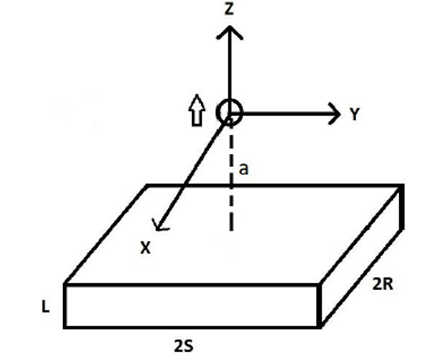
Figure 1 Experimental setup of the system. A spherical permanent magnet is placed above a rectangular superconductor, which was submerged into a liquid nitrogen bath (not shown). The centers of the sphere and the superconductor remain in the same vertical line. The center of the magnet is located a distance a above the upper surface of the rectangle. The empty arrow indicates the magnetic dipole moment μ of the sphere.
The magnet was previously characterized by measuring the magnetic field at different points along the symmetry axis, and it was concluded that it has a magnetic dipole moment
Table 1 List of magnets used to magnetize the superconductor. Nd means a NdFeB magnet and Sm means a SmCo magnet. B magnet is the average field applied to the superconductor in an area of 1 cm X 1 cm and B sc is the magnetic field trapped in the sample.

As B magnet is increased, B sc increases up to a value of 0.35 T. It is clear that the sample could trap higher fields if larger fields were applied. The capability of high-Tc superconductors for trapping magnetic fields has been studied extensively elsewhere9,10. Now, the intention of including this characterization in this study was to compare the measured values of the trapped field with an estimation obtained with the model developed in the next section.
3. Theory
The force between a magnet and a superconductor in the mixed state will be described using two models: magnetic field full expulsion (Meissner state), Sec. 3.1, and penetration of the magnetic field, Sec. 3.2.
3.1 Field expulsion
First, the repulsive force between the magnet and a perfect diamagnet (i.e., a superconductor in the Meissner state) will be calculated. To perform this calculation it is necessary to know the magnetization of the superconducting sample, M(H
a), where H
a is the applied field. In the case of a complete field expulsion from the superconductor, we have
In principle, this equation might be solved by an iterative process. Usually, the magnetization of the superconductor is achieved by numerical calculations, mainly using the finite-element method11-13.
The intention of this work was to obtain full analytical expressions of the forces, but to calculate the demagnetizing field under a nonuniform external field
It will be shown that already, at this level, the model describes adequately the general characteristics of the system.
It is interesting to recall that according to the Bean model of the mixed state, the initial magnetization of an infinite superconducting slab of critical current density
The magnetization of a superconductor of orthorhombic shape in Meissner state has been previously studied theoretically and experimentally14. In that work, small samples of niobium (typically 1.5 mm X 1.5 mm X 1-to-6 mm) were subjected to a uniform external field H
a from 0 to
The force on the superconductor can be calculated by summing up all the infinitesimal interactions
Here, the integration is taken over the whole volume of the superconductor. According to Eq. (3), it can be concluded that the force on the superconductor comes from a potential-energy density
This dipole-dipole model has been used previously to calculate levitation forces in different magnet-superconductor systems, e.g. dipole-cylinder15, bar-cylinder16, dipole-ring17, square-cylinder18, wire-sphere19, and ring-cylinder20.
As shown in Fig. 1, the spherical magnet with dipole moment
It is well known that the magnetic field due to a spherical magnet is the same as the one produced by a point dipole with the same magnetic moment located at the center of the sphere. This field is:
By substituting Eq. (4) in Eq. (3) and changing the sign, the repulsive force ejected on the magnet is obtained. Next, the vertical component of this force is calculated. Vertical
3.1.1 Vertical configuration
When
where g as a function of the independent variable
By taking
Furthermore, when
Finally, if
which is the early expression obtained by Hellman et al.2 with the images method.
The variation of
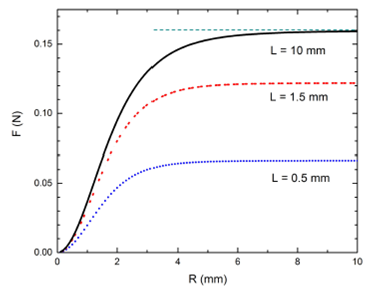
Figure 2 Vertical force (Eqs. (5) and (6)) on a spherical magnet with μ = 2:533 X 10-2 Am 2 as a function of the width of the rectangular superconductor in Meissner state. We took R=S for simplicity. The sphere is placed at a = 3:5 mm above the superconductor, with its magnetization along the z direction. The force grows monotonically and saturates at different levels, depending on the value of L. For a thickness of 10 mm and higher, the saturation force practically coincides with the result given by Eq.(9) for an semi-infinite sample (horizontal discontinuous line).
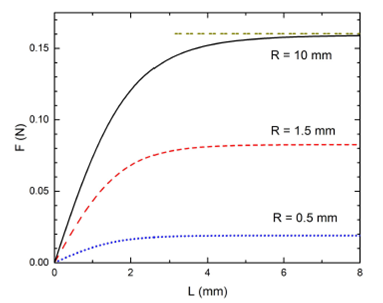
Figure 3 Vertical force (eqs. (5) and (10)) on a spherical magnet with μ = 2:533 X 10-2 Am 2 as a function of the thickness of the superconductor in Meissner state. Again, R = S, a = 3:5 mm and ¹ in the vertical direction. The force grows monotonically with L and reaches a saturation value which depends on R. The horizontal discontinuous line represents the value given by Hellman’s model for a semi-infinite superconductor.
3.1.2 Horizontal configuration
The result of
For
Now, by taking
Again, in the limit of a semi-infinite plane (
3.2 Field penetration
To describe the penetration of the magnetic field in the superconductor, an assumption is made based on the frozen dipole model. A magnetic point dipole represents the behavior of the penetrated region of the sample. This is equivalent to making a multipole expansion of the magnetic field and retaining only the dipole term. In the present model it will be assumed that the dipole appears and stays at the center of the sample. More precisely, the dipole appears in this point when the first critical field
The first critical magnetic field can be obtained from
When the stable levitation of the sphere is reached at
In order to evaluate how reasonable this value is, two fields at the center of the upper
surface of the superconductor were calculated: the one due to the spherical
magnet levitating at its equilibrium position, and the one produced by the
induced dipole
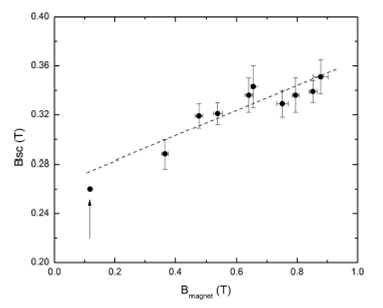
Figure 4 Trapped magnetic field in the rectangular superconductor as a function of the magnetic field of the permanent magnets described in Table I. The data with error bars correspond to the experimental values reported there. The point signaled with an arrow corresponds to the calculated fields produced by the spherical magnet and the induced dipole μ s at the upper surface of the superconductor. This theoretical point is in good agreement with the observed experimental behavior. The dotted line is a guide for the eye.
Based on the experimental observations, it is assumed that the magnitude
where n is an adjusting parameter. Following the idea of the frozen dipole model, it is assumed that when the magnet is moved apart from its equilibrium position,
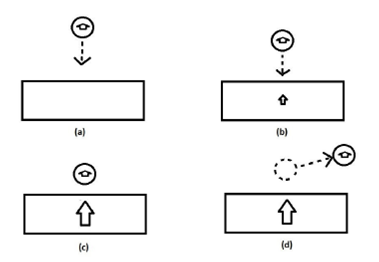
Figure 5 Diagram that illustrates the proposed mechanism of how the superconductor sample is penetrated by the magnetic field of the magnet. (a) No penetration occurs while a>10.6 mm (H a < H c ). (b) Once the critical magnetic field is reached, a magnetic dipole μ s appears and stays at the center of the superconductor; μ s increases when a diminishes, following Eq. (13); 3.5 mm < a < 0.6 mm. (c) μ s reaches its maximum value when the magnet gets the position where the mechanical equilibrium is reached. (d) The induced dipole remains frozen (same value and same position) when the magnet is retrieved.
4. Total force
In this section the combined contributions of the repulsive and attractive forces on the magnet are analyzed. The force ejected by a magnetic dipole
In the vertical configuration of our geometry,
4.1 Vertical
The total vertical force ejected by the superconductor on the magnet is the sum of the calculated from Eqs. (5)-(6) and the 𝑧 component of Eq. (15). In particular, the analysis will be restricted to the case x=0. As mentioned before,
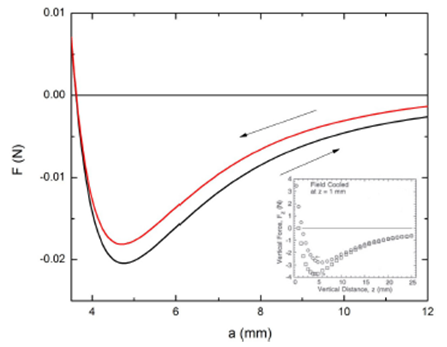
Figure 6 Total vertical force on the magnet as a function of the distance a, calculated with μ = 2:533 X 10-2 A m2, R = S = 5 mm, L = 3.5 mm, and n = 0:8. The weight of the magnet (= 7 X 10-3 N) was not included. The arrows indicate whether the magnet approaches to (upper branch) or moves away from (lower branch) the superconductor. A typical hysteretic FC curve from Ref. 6 is shown in the inset, and a good qualitative agreement with the model is observed.
By the other hand, if n=5, we obtain a typical behavior for a zero field cooling (ZFC) process, as shown in Fig. 7.
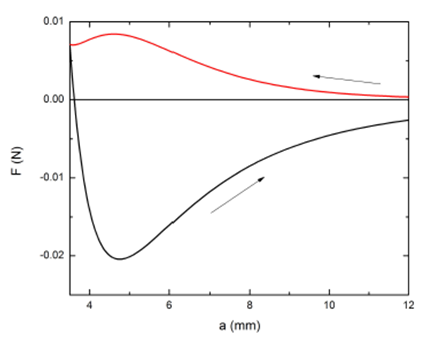
Figure 7 Total vertical force on the magnet as a function of the distance a, calculated with μ= 2:533 X 10-2 A m2, R = S = 5 mm, L = 3.5 mm, and n = 5. Again, the weight of the magnet was not considered here. The arrows indicate that the magnet approaches to and moves away from the superconductor (upper and lower branch, respectively). A typical hysteretic ZFC curve is observed.
4.2 Horizontal
When
Where
For an infinite sample (
The total horizontal force
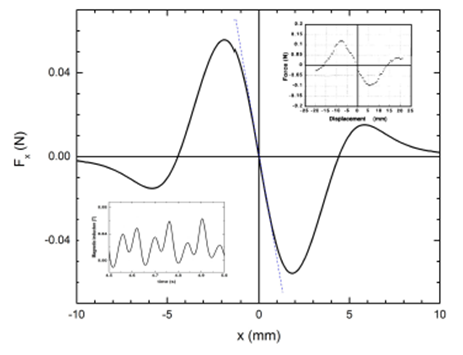
Figure 8 Total horizontal force (continuous line) on the magnet as a function of its position along the X axis. The data used in the calculation are: μ = 2:533 X 10-2 A m2, μ s = 6:95 X 10-3 A m2, R = S = 5 mm, L = 3.5 mm, and a = 3.5 mm. The full curve is antisymmetric in x. The dashed straight line corresponds to a harmonic oscillator behavior. The upper inset shows experimental data taken from Ref. 23, which are in good agreement with the model. The lower inset shows the variation of the magnetic field measured at a fixed point, when the magnet oscillates horizontally around its equilibrium position.
5. Conclusions
The model proposed in the present work neglects the demagnetizing field but provides analytical expressions that describe several aspects of the force between a permanent magnet and a finite superconductor in the mixed state. More precisely, these issues are: i) The dimensions of the superconductor are incorporated in the calculation. In the limit of an infinite superconductor, the repulsive force tends to the proper value. This way, the model allows us to quantify how good/bad is the approximation of taking the sample as infinite. ii) The frozen dipole model was adapted to be applicable to a superconductor with finite thickness. The magnetic moment of this dipole was obtained from the condition of mechanical equilibrium observed experimentally. This value was consistent with our measurements of the magnetic field trapped in the superconductor. iii) The different ways in which the sample can be magnetized were parameterized by an exponent 𝑛. By varying this parameter it was possible to reproduce the typical hysteretic approach/draw-away curves of the total vertical force in FC and ZFC processes. iv) The total horizontal force was calculated as well, and a good agreement with previous experimental results was observed.











 text new page (beta)
text new page (beta)


